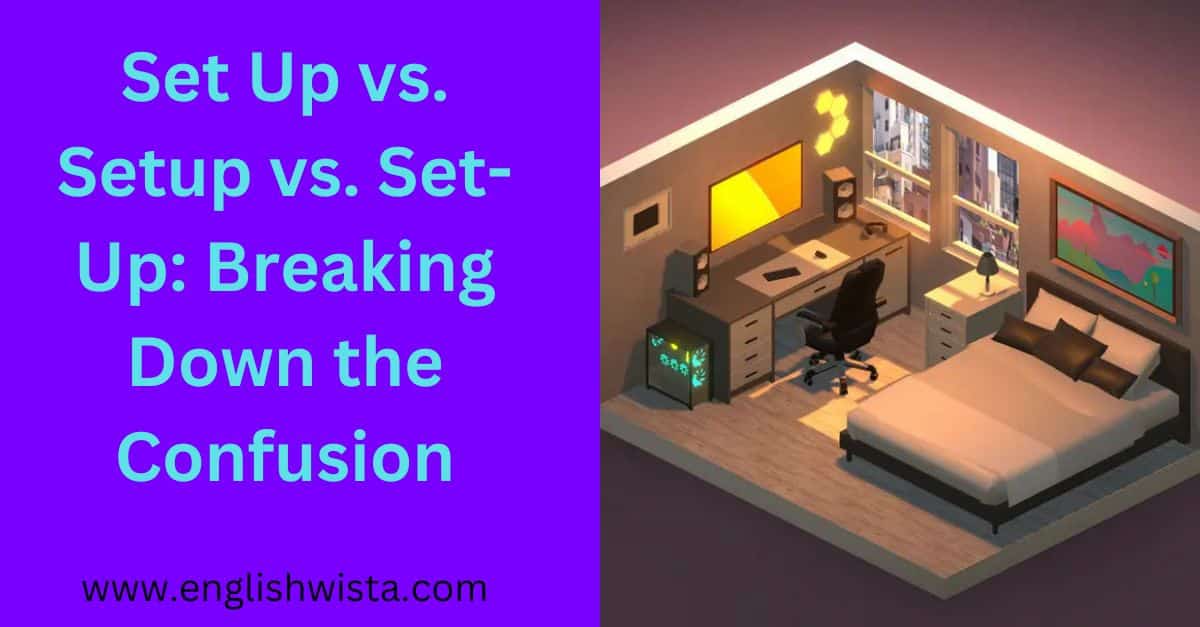Set Up vs. Setup vs. Set-Up—confused yet? Don’t worry, you’re not alone! These seemingly similar terms trip up even the most seasoned writers. But here’s the good news: once you grasp their subtle differences, you’ll never second-guess which one to use again. Whether you’re drafting an email, crafting a report, or writing a blog, mastering this trio will instantly make your work look sharper and more professional.
Think about it: how often do you pause mid-sentence, wondering, “Is this one word or two? Should there be a hyphen?” By the end of this guide, you’ll confidently navigate these tricky choices like a pro. Let’s dive in!
What’s the Difference?
The confusion comes from how “setup,” “set up,” and “set-up” are used in different contexts. The secret lies in understanding their roles in a sentence:
- Setup (one word) is a noun or an adjective.
- Set up (two words) is a verb.
- Set-up (with a hyphen) is a less common variation, typically used as a noun.
Let’s break it down further.
Setup: The Noun or Adjective
The word “setup” describes a thing or an arrangement. Think of it as the result of putting something together. It’s often used in tech, events, or general scenarios where something needs to be prepared or arranged.
Examples:
- “The setup for the party took hours.”
- “The new software setup is easy to follow.”
- “He praised the setup of the home theater system.”
Here, “setup” is a noun because it refers to the arrangement or process. You might also see “setup” used as an adjective, as in “setup instructions.”
Set Up: The Verb
When “set up” is two words, it’s an action. It means to arrange, organize, or establish something. Think of it as what you do to create a “setup.”
Examples:
- “Let’s set up the chairs for the meeting.”
- “She set up her new phone yesterday.”
- “Can you help me set up the Wi-Fi?”
In these cases, “set up” is an action that involves putting something into place or organizing it.
Set-Up: The Hyphenated Noun
“Set-up” is an older style of writing the noun form. While it’s still correct, it’s less common in modern English. Many writers and editors prefer the one-word form, “setup.”
Examples:
- “The set-up of the prank was elaborate.”
- “He explained the set-up of the new office layout.”
If you’re unsure, stick with “setup” as the standard noun.
How to Remember the Difference
Here’s a simple trick:
- Use “setup” (one word) when talking about a thing or arrangement.
- Use “set up” (two words) when describing an action.
- Use “set-up” (hyphenated) if it’s a noun and you’re following a style guide that prefers this form.
Practice Sentences
To lock it in, try filling in the blanks:
- “We need to _______ the tables before the guests arrive.”
- “The _______ for the photoshoot was stunning.”
- “The _______-up of the trick was complicated.”
(Answers: 1. set up, 2. setup, 3. set-up)
Why Does This Matter?
Small details like this can change the meaning of a sentence or make your writing appear more polished. Knowing the difference ensures clarity, especially in professional settings like emails, reports, or instructions.
Real-Life Examples
Let’s look at some side-by-side comparisons:
- “I need to set up my desk.” (verb: action)
- “The setup of my desk is ergonomic.” (noun: arrangement)
- “The set-up of the scam was clever.” (noun: arrangement)
Fun Fact: Word Origins
The phrase “set up” has been around for centuries, originating from Old English. Over time, its use evolved, leading to the modern forms “setup” and “set-up.”
Common Questions
Is “setup” singular or plural?
“Setup” is singular. The plural form is “setups.”
Examples:
- Singular: “This setup is perfect.”
- Plural: “All the setups are ready.”
Can “setup” and “set up” be used interchangeably?
No. Using “setup” where “set up” is needed (or vice versa) can confuse readers. Stick to the rules for clarity.
Quick Reference Guide
| Form | Part of Speech | Usage Example |
|---|---|---|
| Setup | Noun/Adjective | “The setup is complete.” |
| Set up | Verb | “I will set up the meeting room.” |
| Set-up | Noun | “The set-up of the joke was brilliant.” |
Conclusion
Understanding when to use “setup,” “set up,” or “set-up” doesn’t have to be tricky. Remember the basic rule: “setup” is a thing, “set up” is an action, and “set-up” is the less common noun. With these tips and examples, you’ll feel confident choosing the right one every time. Next time you write, you can smile knowing you’ve mastered this common English challenge!



